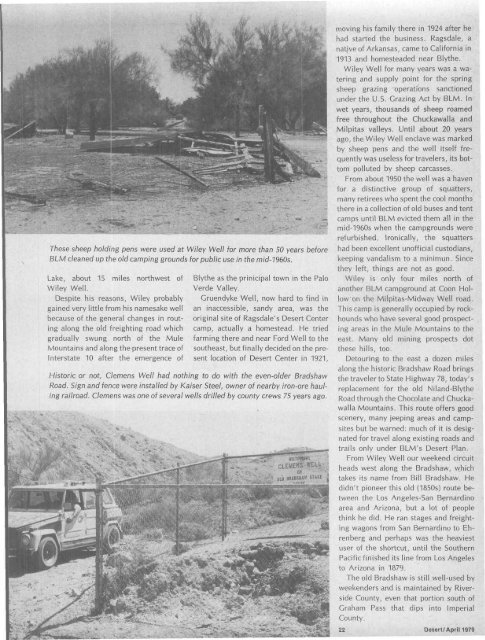Come - Desert Magazine of the Southwest
Come - Desert Magazine of the Southwest
Come - Desert Magazine of the Southwest
You also want an ePaper? Increase the reach of your titles
YUMPU automatically turns print PDFs into web optimized ePapers that Google loves.
These sheep holding pens were used at Wiley Well for more than 50 years before<br />
BLM cleaned up <strong>the</strong> old camping grounds for public use in <strong>the</strong> mid-1960s.<br />
Lake, about 15 miles northwest <strong>of</strong><br />
Wiley Well.<br />
Despite his reasons, Wiley probably<br />
gained very little from his namesake well<br />
because <strong>of</strong> <strong>the</strong> general changes in routing<br />
along <strong>the</strong> old freighting road which<br />
gradually swung north <strong>of</strong> <strong>the</strong> Mule<br />
Mountains and along <strong>the</strong> present trace <strong>of</strong><br />
Interstate 10 after <strong>the</strong> emergence <strong>of</strong><br />
Bly<strong>the</strong> as <strong>the</strong> prinicipal town in <strong>the</strong> Palo<br />
Verde Valley.<br />
Gruendyke Well, now hard to find in<br />
an inaccessible, sandy area, was <strong>the</strong><br />
original site <strong>of</strong> Ragsdale's <strong>Desert</strong> Center<br />
camp, actually a homestead. He tried<br />
farming <strong>the</strong>re and near Ford Well to <strong>the</strong><br />
sou<strong>the</strong>ast, but finally decided on <strong>the</strong> present<br />
location <strong>of</strong> <strong>Desert</strong> Center in 1921,<br />
Historic or not, Clemens Well had nothing to do with <strong>the</strong> even-older Bradshaw<br />
Road. Sign and fence were installed by Kaiser Steel, owner <strong>of</strong> nearby iron-ore hauling<br />
railroad. Clemens was one <strong>of</strong> several wells drilled by county crews 75 years ago.<br />
moving his family <strong>the</strong>re in 1924 after he<br />
had started <strong>the</strong> business. Ragsdale, a<br />
native <strong>of</strong> Arkansas, came to California in<br />
1913 and homesteaded near Bly<strong>the</strong>.<br />
Wiley Well for many years was a watering<br />
and supply point for <strong>the</strong> spring<br />
sheep grazing operations sanctioned<br />
under <strong>the</strong> U.S. Crazing Act by BLM. In<br />
wet years, thousands <strong>of</strong> sheep roamed<br />
free throughout <strong>the</strong> Chuckawalla and<br />
Milpitas valleys. Until about 20 years<br />
ago, <strong>the</strong> Wiley Well enclave was marked<br />
by sheep pens and <strong>the</strong> well itself frequently<br />
was useless for travelers, its bottom<br />
polluted by sheep carcasses.<br />
From about 1950 <strong>the</strong> well was a haven<br />
for a distinctive group <strong>of</strong> squatters,<br />
many retirees who spent <strong>the</strong> cool months<br />
<strong>the</strong>re in a collection <strong>of</strong> old buses and tent<br />
camps until BLM evicted <strong>the</strong>m all in <strong>the</strong><br />
mid-1960s when <strong>the</strong> campgrounds were<br />
refurbished. Ironically, <strong>the</strong> squatters<br />
had been excellent un<strong>of</strong>ficial custodians,<br />
keeping vandalism to a minimun. Since<br />
<strong>the</strong>y left, things are not as good.<br />
Wiley is only four miles north <strong>of</strong><br />
ano<strong>the</strong>r BLM campground at Coon Hollowon<br />
<strong>the</strong> Milpitas-Midway Well road.<br />
This camp is generally occupied by rockhounds<br />
who have several good prospecting<br />
areas in <strong>the</strong> Mule Mountains to <strong>the</strong><br />
east. Many old mining prospects dot<br />
<strong>the</strong>se hills, too.<br />
Detouring to <strong>the</strong> east a dozen miles<br />
along <strong>the</strong> historic Bradshaw Road brings<br />
<strong>the</strong> traveler to State Highway 78, today's<br />
replacement for <strong>the</strong> old Niland-Bly<strong>the</strong><br />
Road through <strong>the</strong> Chocolate and Chuckawalla<br />
Mountains. This route <strong>of</strong>fers good<br />
scenery, many jeeping areas and campsites<br />
but be warned: much <strong>of</strong> it is designated<br />
for travel along existing roads and<br />
trails only under BLM's <strong>Desert</strong> Plan.<br />
From Wiley Well our weekend circuit<br />
heads west along <strong>the</strong> Bradshaw, which<br />
takes its name from Bill Bradshaw. He<br />
didn't pioneer this old (1850s) route between<br />
<strong>the</strong> Los Angeles-San Bernardino<br />
area and Arizona, but a lot <strong>of</strong> people<br />
think he did. He ran stages and freighting<br />
wagons from San Bernardino to Ehrenberg<br />
and perhaps was <strong>the</strong> heaviest<br />
user <strong>of</strong> <strong>the</strong> shortcut, until <strong>the</strong> Sou<strong>the</strong>rn<br />
Pacific finished its line from Los Angeles<br />
to Arizona in 1879.<br />
The old Bradshaw is still well-used by<br />
weekenders and is maintained by Riverside<br />
County, even that portion south <strong>of</strong><br />
Graham Pass that dips into Imperial<br />
County.<br />
22 <strong>Desert</strong>/ April 1979
















